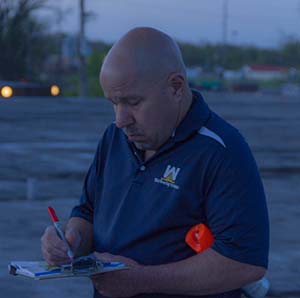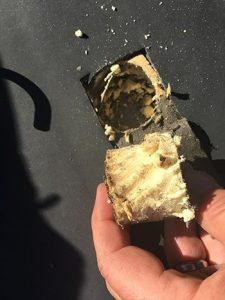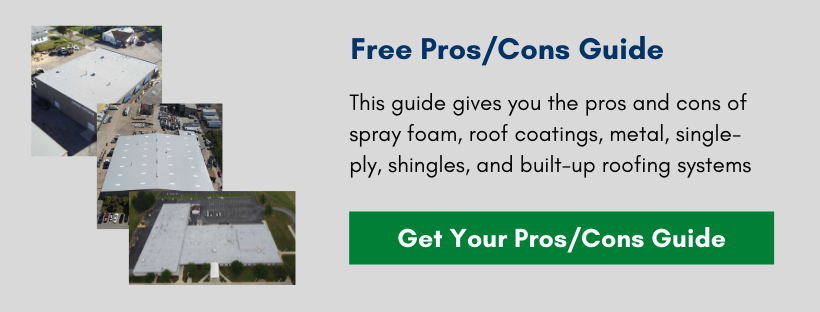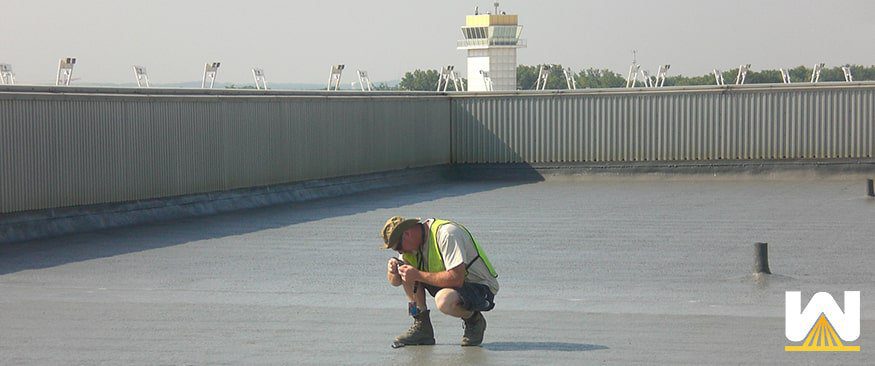Perhaps you recently noticed brown spots on your ceiling, or you’ve witnessed water dripping from your roof.
Either way, it’s time to take action and get your problem fixed.
What should you do first?
Your first step is to call a couple of commercial roofing contractors and get free inspections.
You want to call a few contractors to see what discoveries they find, what the prices are, what options they give you, etc. This will help you pick the best option for you and your building.
Roofing contractors perform free inspections with the hope of getting the job after their assessment.
Most roofing contractors will perform free commercial roofing inspections. If they don’t, then choose someone else. It only makes sense that the contractor who performs the best inspection will probably get the job.
The best inspections are produced by:
- Proposing a solution that fixes your problem
- Finding every opportunity water has to enter the building
- Finding a cost-effective solution
- Explaining the deficiencies and solutions in an easy-to-understand manner
- And much more
At West Roofing Systems, we’ve seen all kinds of roofing inspections, discoveries, and recommendations given to building owners since 1979.
But what goes on during the actual inspection? Today we’ll go from start to finish on what you can expect to see happen during a commercial roof inspection.
What Happens During a Commercial Roofing Inspection?
A commercial roof inspection starts from the inside
A professional roofing contractor will begin a roof inspection from inside the building. The reason is to see where water is concluding its route. Where water ends its path is an excellent indication of where the leak began.
For example, if there are water stains in the bathroom, the location straight above the bathroom on your roof is a great estimate of where water enters the building.
Another indication is a penetration near that area. For example, if an HVAC unit is directly above the bathroom on the roof, a great guess is that the leak starts near this area.

A commercial roof inspection includes walking the roof
A professional roofing contractor will walk the roof in search of unusual circumstances, such as:
- Ponding water
- Holes in the substrate
- Cracks
- Blisters
- Uplifted seams
- Uplifted nails and/or shingles
- And much more
A roofer will start from the roof’s perimeter and work their way towards the middle of the roof. One reason is that you ensure you don’t forget an area of the roof. Another reason is that perimeter edges are areas with a higher probability of causing a leak than the roof field.
The reason is that perimeter edges are endpoints on a roofing system, which can be lifted by the wind. This usually causes the edges to lose adhesion on a single-ply roofing system before the roof field.
A commercial roof inspection includes taking a few core samples
What is a core sample? A core sample is the removal of a small portion of the roof to determine facts about it, including:
- How many roofing layers are there?
- What material is the substrate?
- The level of saturation and/or moisture
- How old is the roof?
Here’s an example of a core sample:

If there’s a drop ceiling or circumstance where you cannot see the roof deck from the inside, a core sample will tell you what type of decking is present (wood, steel, concrete, etc.).
During a commercial roof inspection, the number of core samples will vary depending on the size of the roof, slope, where water travels, and highlighted areas during the internal inspection.
On average, a roofing contractor will take 1-2 core samples for every 10,000 sq. ft. of your roof. A roofing contractor will repair the area once the inspection is complete.
A commercial roof inspection includes a report
After the visual inspection and core samples have been taken, a detailed report will be given to the building owner.
The report will include areas causing leaks, places on the roof that are saturated, photos of these areas, and recommendations going forward.
These recommendations can include whether to repair, restore or replace your roof. Here are examples of when each of these could be recommended:
Repair – after your inspection, less than 5% of your roof is saturated, and only a few areas allow water to enter the building. If the remainder of your roof is in good condition, the most cost-effective solution is to repair these areas.
Restore – after your inspection, less than 25% of your roof is saturated, but the remaining lifetime of your roof is less than 2-3 years. If restoration is not performed, a complete tear-off will likely need to happen at the end of that third year. A complete tear-off is estimated to be 3-4x more expensive than a restoration.
Replace – after your inspection, more than 25% of your roof is saturated. It would be more cost-effective to replace the entire roof instead of repairing a large portion of your roof, with more repair likely in the near future. This is similar to replacing an expensive car part (say, a $1200 transmission) on a 20-year-old car that will likely need other repairs very soon.
How long does a commercial roof inspection take?
You may wonder, “How long will a roofing contractor be on my property?” For an average 20,000 sq. ft. commercial building, it takes approximately 30 minutes to 1 hour to perform a roof inspection.
A roof inspection can take shorter or longer depending on:
- How many penetrations are the roof (each one needs to be inspected thoroughly)
- How many roof sections are there (every area is inspected differently)
- How many different types of roofs are there
Once the roof inspection is complete, you sit back and wait for the report to come.
How long until I receive my commercial roof inspection report?
A roof inspection report is usually sent to the building owner in 3-5 days.
What will be included in the inspection report?
Inspection reports will include the following:
- the deficiencies within your current roof system w/photos and clear explanations
- what options do you have in repairing your roof
- a quote for the work proposed
Once you collect a few quotes from other roofing contractors, then it’s time to compare them and make the best decision for your business.
What are your next steps after you receive a roof inspection?
Once you receive multiple roofing inspections and quotes, it’s time to review them.
Which company made the best recommendations?
Which company found the most deficiencies (that were actually deficiencies)?
And which company has the most cost-effective solution to fix my problem?
At West Roofing Systems, we’re happy to walk building owners through the entire process and discuss the potential options with you, whether we decide to work together or not.
We’re just trying to help educate building owners as much as possible so they can make the best decision for their roofs.
Need more insight?
Read More: Lies roofing contractors tell after you receive your roof inspection.
This post will tell you:
- how roofing contractors lie about having their own in-house roofers
- how they lie about the price
- how they lie about getting you to perform a more expensive solution
- how they lie about what’s covered in the warranty


